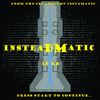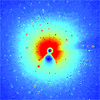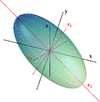issue contents
October 2020 issue

Cover illustration: Protein microcrystals in living insect cell cultures can be detected rapidly and with high sensitivity by their characteristic small-angle X-ray scattering/X-ray powder diffraction profiles [Lahey-Rudolph et al. (2020). J. Appl. Cryst. 53, 1169-1180].
research papers
 access
access access
access access
access

 access
accessA DigitalMicrograph script named InsteaDMatic has been developed for automated continuous rotation electron diffraction (cRED) data acquisition. InsteaDMatic coordinates functions of the transmission electron microscope goniometer and camera in order to tune up diffraction-frame recording simultaneously with crystal rotation. Exploiting fast and automated data collection, the influence of the electron dose rate on the quality of cRED data was studied, and structural models obtained for two different parallel-beam illumination modes (aperture selection and nanoprobe) were compared.
 access
access access
access



 journal menu
journal menu















































